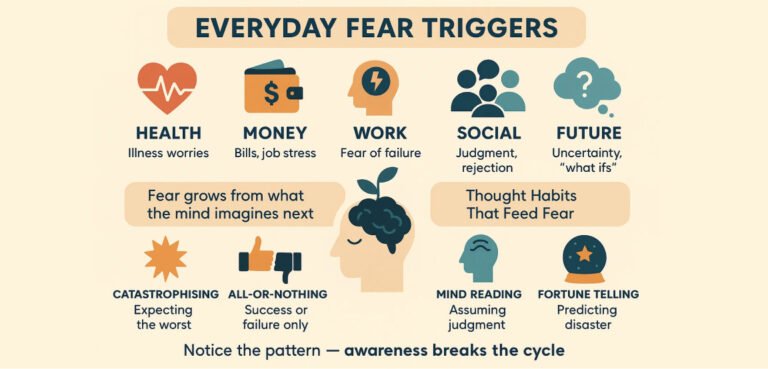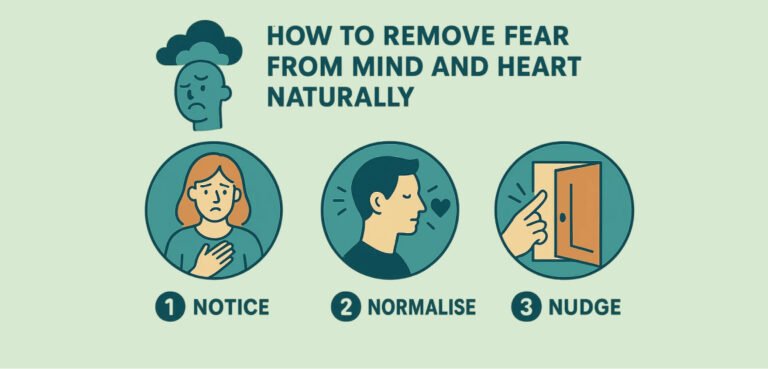No products in the cart.
If you’ve ever wondered how to remove fear from mind and heart, the truth is — you can’t erase fear completely, but you can turn its volume down and stop it from running your life. This guide walks you through practical ways to do that: body tools to calm your system, mindset shifts to quiet racing thoughts, daily habits that build confidence, mindfulness techniques to stay grounded, and when to reach out for help if fear starts to take over.

Here’s what you’ll get: simple, proven methods to relax your body, ease anxious thinking, and handle challenges with more peace and control.
What Does Fear Do to Your Mind and Heart?
Fear isn’t a flaw — it’s part of your built-in safety system. Your brain and body developed it to keep you alive, not to make you miserable. The problem is that the same system can sometimes stay “switched on” for too long, even when there’s no real danger. To learn how to remove fear from mind and heart, it helps to first understand exactly what fear does inside you.
In Your Mind
When fear hits, your brain’s amygdala — the part that detects threats — takes over. It sends alarm signals before you’ve even had time to think. This is why your mind suddenly feels rushed and chaotic. You might notice:
- Racing thoughts — jumping from one worry to the next, imagining the worst-case scenario.
- Narrow focus — everything outside the problem seems to fade, like you’re trapped in a “threat tunnel.”
- Distorted thinking — fear exaggerates danger, making small issues feel enormous.
- Reduced logic — your reasoning brain (the prefrontal cortex) goes quiet while survival instincts take control.
In short, fear pulls you out of clear thinking and into protective overdrive. That’s useful if you’re avoiding a real threat — but exhausting if it’s triggered by an email, a bill, or what someone might think of you.
In Your Body
Fear doesn’t just live in your head; it’s written all over your body. As soon as your brain senses a threat, it activates the fight-or-flight response — a rush of stress hormones like adrenaline and cortisol. You might feel:
- A pounding or racing heart, sending blood to your muscles.
- Tightness in the chest or throat, as your body braces for action.
- Shallow breathing, which limits oxygen and can make you feel dizzy.
- Tense muscles, especially in your neck, shoulders, or stomach.
- Sweaty palms or trembling are signs of your nervous system on high alert.
These changes aren’t random — they’re designed to prepare you to run or fight. But when there’s no real danger, that same reaction just makes you uncomfortable and tired.
Short vs Long Term
A short burst of fear can be helpful. It sharpens your senses, speeds up reaction time, and helps you stay alert in a risky moment — like avoiding a car that’s too close or reacting to a sudden noise.
However, chronic or ongoing fear is a different story. When your body and mind stay in “alert mode” for days or weeks, it starts to wear you down. You might:
- Feel restless, on edge, or easily startled.
- Struggle to sleep, think clearly, or make decisions.
- Experience constant fatigue or stomach issues.
- Notice that small problems feel overwhelming.
That’s why the tools in the next sections matter. They teach your brain and body to turn the alarm off once the danger has passed. When you understand what fear is doing, you can respond to it — not just react. Over time, that’s how you start to quiet fear in both your mind and heart.
Why Do We Feel Fear in Everyday Life?

Fear isn’t just for life-or-death moments — it shows up in everyday life because your brain is wired to look for uncertainty and protect you from it. Learning how to remove fear from mind and heart starts with seeing that fear isn’t weakness; it’s a natural reaction to things you care about. But sometimes, your brain confuses “uncomfortable” with “unsafe.”
Biology & Uncertainty
Your body’s fear system — mainly the amygdala and stress hormones like adrenaline and cortisol — evolved to handle sudden threats. Thousands of years ago, that might have meant spotting a predator. Today, it might mean opening a difficult email or seeing your bank balance.
The link between fear and uncertainty is key: when you don’t know what will happen next, your brain fills in the blanks — usually with the worst-case scenario. It believes that imagining danger might somehow protect you. Unfortunately, that same instinct keeps you in a constant state of tension and worry, even when nothing bad is happening.
Common Modern Triggers
Every day life gives fear plenty of places to hide. Here are some of the most common triggers people notice:
- Health: worrying about symptoms, illness, or the well-being of loved ones.
- Money: job insecurity, bills, or unexpected expenses.
- Work or studies: fear of failing, being judged, or not keeping up.
- Social judgment: worrying about what others think, being rejected, or making mistakes in public.
- Uncertainty about the future: changes, global news, or simply not knowing what’s next.
Fear is rarely about one event — it’s about what your mind imagines could happen next.
Thought Habits That Feed Fear
Fear grows when certain thinking habits take over. Some of the most common are:
- Catastrophising: jumping straight to the worst outcome (“If I mess this up, I’ll lose everything”).
- All-or-nothing thinking: seeing things as total success or total failure, with no middle ground.
- Mind reading: assuming you know what others think about you — and that it’s negative.
- Fortune telling: predicting disaster before it even starts.
These patterns are learned, but they can be unlearned. The first step is awareness.
How to Remove Fear from Mind and Heart Naturally

Now that you understand what fear does and why it shows up, let’s talk about how to remove fear from mind and heart naturally — in a way that’s gentle, practical, and works with your body, not against it. Fear can’t simply be “deleted,” but you can retrain your mind and nervous system to respond differently each time it appears.
The 3-Step Loop: Notice – Normalise – Nudge
1. Notice:
The first step is simply to pause and name what’s happening. Say quietly to yourself, “I’m feeling fear right now.” This one small act separates you from the feeling. You’re no longer inside the storm — you’re watching it. Naming fear engages the rational part of your brain and starts to calm your body’s alarm system.
2. Normalise:
Next, remind yourself, “This is my body trying to protect me.” Fear isn’t proof that something’s wrong with you — it’s your safety system doing its job. Once you see fear as protection, not punishment, you stop fighting it and start guiding it. This small mindset shift lowers stress chemicals and helps your breathing steady again.
3. Nudge:
Finally, take a small step that sends your body and brain the message: I’m safe. That could mean:
- Take three slow breaths in and out through your nose and mouth.
- Grounding yourself — feel your feet on the floor, notice five things you can see.
- Reframing the thought (“This is uncomfortable, not dangerous”).
- Doing one small action — like replying to one email or stepping outside for air.
Each time you go through this loop, your fear system learns to reset faster. Over time, fear still visits — but it doesn’t take charge.
Common Traps to Avoid
While you practise calming fear, try to steer clear of habits that silently fuel it:
- Doomscrolling late at night: constant negative news keeps your brain stuck in alert mode.
- Too much caffeine: even one extra cup can mimic anxiety symptoms and trick your brain into panic.
- Skipping meals or sleep: low blood sugar and fatigue make your body more sensitive to stress.
These may sound small, but together they can undo your progress. Balance, rest, and steady routines are your real fear-fighters.
If you’d like a deeper breakdown of how to retrain your mind and body, read the full guide on Wise Campus – How Do You Remove Fear from Your Mind and Heart? — It expands on this loop with practical exercises, mindset shifts, and simple everyday tools you can start using right now to calm fear naturally.
Simple Breathing and Relaxation Techniques to Calm Fear
When fear rises, your breath is the fastest way to calm both your mind and body. You don’t need any equipment or special setting — just a few moments of focus. Here are three simple techniques you can use anytime, anywhere to help quiet your nervous system and regain control.
60-Second Reset (Physiological Sigh)
This is a quick, proven way to lower stress within a minute.
- Inhale slowly through your nose.
- Take a small extra “top-up” inhale.
- Then exhale long and slow through your mouth.
- Repeat 5–8 cycles.
- You’ll feel your heart rate slow and your chest loosen — a physical signal to your brain that the threat has passed.
Box Breathing (4–4–4–4)
This steady pattern builds calm through rhythm and control.
- Inhale for 4 seconds.
- Hold for 4 seconds.
- Exhale for 4 seconds.
- Hold again for 4 seconds.
- Continue for 2–4 minutes.
- This is especially useful before meetings, driving, or when you feel overwhelmed. It restores balance and focus by resetting your breathing rhythm.
Progressive Release
Fear often hides as muscle tension, so this method teaches your body to let go.
- Tense your jaw, shoulders, hands, stomach, and calves for a few seconds.
- Then exhale slowly and release all the tension.
- Notice the difference between tight and relaxed.
- Repeat this sequence once or twice until your body feels grounded again.
Practising these tiny tools every day — not just during panic — helps your body learn what calm feels like. Over time, your nervous system begins to settle faster after stress.
If you’d like to go deeper into how breathing, awareness, and relaxation work together, explore the Mindfulness Diploma Course on Wise Campus. It’s designed to help you build long-term calm through guided mindfulness practices, emotional awareness, and techniques for managing stress in daily life.
How Positive Thinking Helps You Overcome Fear
Positive thinking isn’t about pretending everything is fine when it isn’t. It’s about choosing a balanced and realistic view, even when fear wants to make everything look worse than it is. When you learn how to remove fear from mind and heart, one of the most powerful shifts is noticing the story you’re telling yourself — and gently rewriting it.
Realistic positivity starts with reframing. Instead of thinking, “I’ll never get through this,” you might say, “This is hard, but I’ve handled tough things before.” It doesn’t deny the struggle; it reminds your brain that you’re capable. Each time you do this, your mind builds evidence that you can cope, and the fear loses some of its force.
When fear starts talking loudly, pause and do a quick evidence check. Ask yourself: “Is this thought a fact, or just a fear?” “What proof do I actually have?” “What would I say to a friend who felt this way?” These small questions pull you back to reality and stop your mind from spinning in circles.
But the most important part of overcoming fear is movement. Action beats rumination — always. Take one tiny step forward, even if it’s small: send that email, step outside for air, or tidy one corner of your space. The moment you act, your brain shifts from worry mode to problem-solving mode, and that’s where calm begins to return.
Easy Daily Habits to Build Inner Confidence
Fear weakens when your body and mind feel steady. Confidence isn’t just mental — it’s built from the small things you do every day that tell your nervous system, “I’m safe and in control.” Learning how to remove fear from mind and heart becomes much easier when your daily habits support calm rather than chaos.
Foundations: Sleep, Movement, and Fuel
Your body is the base of your confidence. Try to get enough sleep — it resets your stress hormones and sharpens thinking. Keep movement simple and regular; even a 10-minute walk, a stretch, or gentle breathing loosens tension and clears your head. Feed yourself regularly with balanced meals to avoid dips in blood sugar that can mimic anxiety. These three — sleep, movement, and food — are your calm foundations.
Boundaries: Caffeine, News, and Screen Time
Fear thrives on stimulation, and too much caffeine, news, or scrolling keeps your system on alert. If you rely on coffee, stop by mid-afternoon to avoid racing thoughts at night. Limit news checks to once or twice a day instead of constant updates. And give yourself screen-free time — even 30 minutes before bed helps your mind cool down. Setting these small boundaries teaches your brain to relax again.
Connection: 10-Minute Check-In
Fear shrinks in safe company. Make a habit of connecting with one person a day — a quick call, a chat, or even a message. Human connection releases calming chemicals like oxytocin that lower anxiety and remind you you’re not alone. If you’re having a hard day, talk it out instead of bottling it up. A 10-minute check-in can change the tone of your whole day.
When these small habits stack together — sleep, movement, mindful limits, and genuine connection — they become your everyday confidence system. They won’t remove fear instantly, but they’ll make you stronger and calmer when it shows up.
When to Seek Support for Deep or Ongoing Fear
It’s completely normal to feel afraid from time to time — but if fear starts to take over your daily life, it’s a sign you might need extra support. Knowing when to get help is not a weakness; it’s wisdom. Sometimes your body and mind just need a bit more care than self-help tools can give.
Signs It’s Time to Get Help
Reach out for professional help if:
- Fear or anxiety lasts for several weeks or longer, without easing up.
- You experience panic attacks, sudden heart pounding, or feelings of losing control.
- You start avoiding people, places, or situations that used to feel normal.
- Your sleep collapses — you can’t fall asleep, or you wake up anxious in the night.
- You notice flashbacks, nightmares, or links to past trauma.
- You begin using alcohol, drugs, or overeating to numb your fear.
These are signals that your nervous system is overloaded — and that getting help could make a real difference.
Where to Start
You don’t have to face this alone. Start with someone you trust and who can guide you to the right support:
- Your GP or primary care doctor — they can check your health, explain options, and refer you to therapy.
- A licensed therapist or counsellor — they can teach practical tools to manage fear, anxiety, and panic safely.
- Trusted helplines or local mental health services — many offer free, confidential support 24/7.
Taking this step doesn’t mean something is “wrong” with you — it means you’re choosing to heal with help.
Urgent Help Note
If you ever feel in immediate danger or think you might hurt yourself, please seek help right away. In the UK, you can call 999 for emergency support or reach out to Samaritans at 116 123 for free, confidential help at any time. If you’re outside the UK, contact your local emergency number or mental health helpline. You are not alone — help is available right now.
Final Thoughts: Living Peacefully Without Fear
Fear will always be part of being human — but it doesn’t have to control you. Remember, fear is information, not a life sentence. When you meet it with calm, care, and consistent practice, it naturally softens over time. For the next seven days, try a simple micro-plan to help your mind and body feel safer: use one breathing tool each morning, such as the 60-second reset; keep one healthy boundary, like turning off screens 30 minutes before bed; and take one tiny action you’ve been avoiding — reply to a message, make a call, or step outside for a short walk. Each small action is a quiet vote for calm and confidence. You don’t need to erase fear completely; you just need to keep teaching your body and mind what safety feels like. With steady practice, peace becomes less of a wish — and more of your natural state.
Frequently Asked Questions
1. How to stop fear in mind?
- You can’t delete fear, but you can calm it. Try pausing, naming what you feel, and taking three slow breaths. This helps your brain switch from panic to control.
2. How to stop being so scared?
- Start with small, safe actions that build confidence. Each time you face what scares you — even a little — your mind learns you can handle it.
3. What causes fear in the brain?
- Fear starts in the amygdala, the brain’s alarm system. It reacts to danger (real or imagined) and sends signals that speed up your heart and tense your body.
4. Why am I such a fearful person?
- You’re not weak — you’re human. Fear often comes from past experiences, high stress, or a habit of imagining the worst. With practice, you can retrain your reactions.
5. What is the root cause of fear?
- At its core, fear comes from uncertainty — your brain trying to predict and avoid danger. The less control you feel, the louder fear becomes.
6. What are 7 warning signs of stress?
- Common signs include tension, poor sleep, headaches, irritability, fatigue, racing thoughts, and changes in appetite.
7. What are 5 early warning signs of mental illness?
- Look for ongoing sadness, withdrawal from others, poor focus, sleep problems, and loss of interest in things you used to enjoy.
8. How to check your stress level?
- Notice your body first — tense shoulders, shallow breathing, or a fast heartbeat are early signs your stress is building.
9. How to reset your body from chronic stress?
- Start with rest, regular meals, gentle exercise, and deep breathing. Reducing caffeine and practising mindfulness also helps your body reset naturally.







